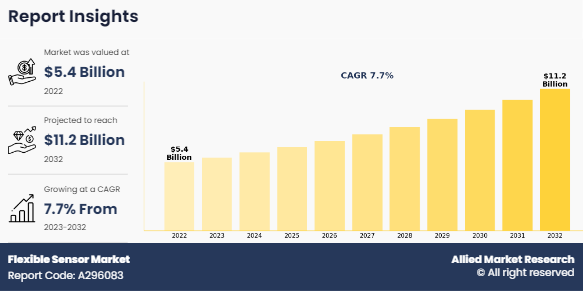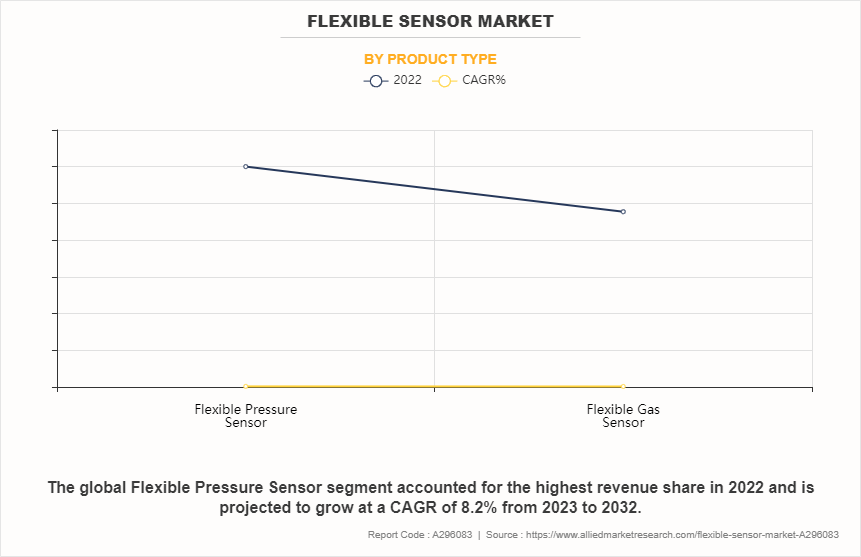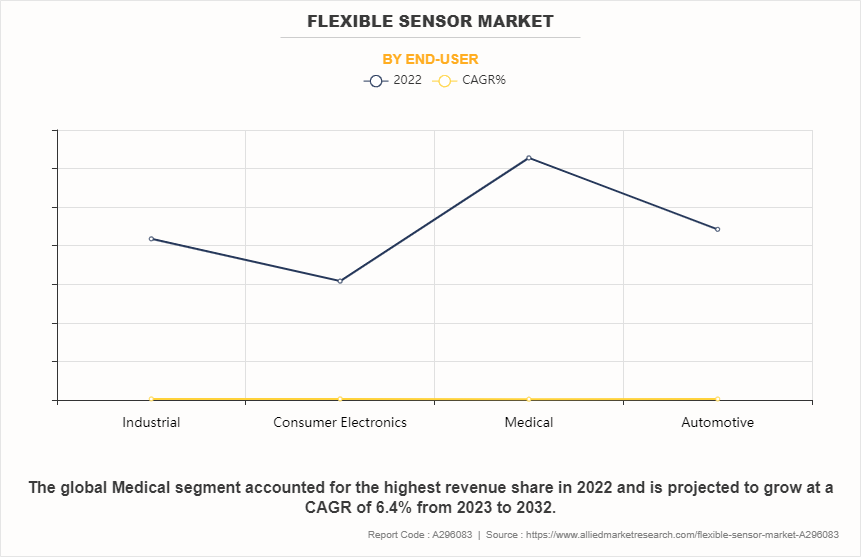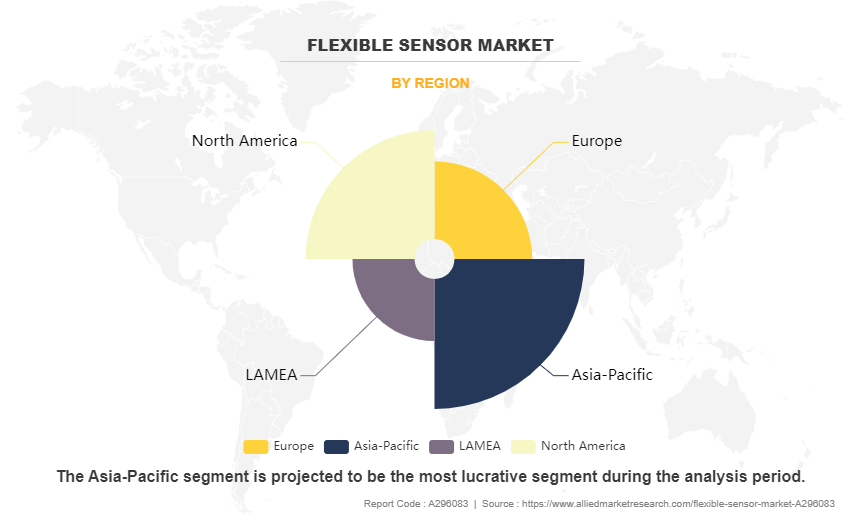Flexible Sensor Market Research, 2032
The Flexible Sensor Market was valued at $5.4 billion in 2022, and is projected to reach $11.2 billion by 2032, growing at a CAGR of 7.7% from 2023 to 2032.
The rising trend towards automotive industry is incorporating flexible sensors into various applications, including interior comfort systems, safety features, and environmental monitoring. Trends such as autonomous driving and electric vehicles are further fueling the demand for sensor technologies.

A flexible sensor is a type of electronic sensor that is designed to be flexible, conformable, or stretchable, allowing it to adapt to the shape of curved or irregular surfaces. Unlike traditional rigid sensors, flexible sensors can be integrated into flexible materials, such as textiles, films, or elastomers, making them suitable for applications where conformability and adaptability are essential. These sensors are typically composed of flexible materials or substrates, often using polymers or other flexible compounds. The flexibility of the sensor allows it to be used in various applications where traditional rigid sensors may not be practical. Flexible sensors are employed in diverse fields, including wearable technology, healthcare, robotics, automotive systems, and industrial monitoring.
Key Takeaways
- By product type, the flexible pressure sensor sub-segment emerged as the leader in 2022 and anticipated to be the fastest growing during the forecast period.
- By end-user, the medical sub-segment emerged as the global leader in 2022 and consumer electronics is projected to show the fastest growth in the upcoming years.
- By region, Asia-Pacific registered the highest market share in 2022 and North America is projected to maintain its position during the forecast period.
Segment Overview
The flexible sensor market is segmented into Product Type and End-User.

On the basis of Product Type, the flexible pressure sensor segment dominated the global flexible sensor market share in 2022. Flexible pressure sensors play a crucial role in healthcare applications, including continuous monitoring of vital signs, patient diagnostics, and medical implants. With the growing demand for remote patient monitoring and telehealth services, the need for flexible pressure sensors is increasing. The flexible sensor companies increasing adoption of wearable devices such as fitness trackers, smartwatches, and healthcare monitoring devices is driving the demand for flexible pressure sensors. These sensors are essential components in wearable devices for tracking various parameters such as heart rate, blood pressure, and physical activity. Flexible sensor companies are utilized in industrial automation and robotics for applications such as material handling, quality control, and human-machine interaction. As industries adopt more automated and robotic solutions, the demand for flexible sensor market opportunity to enable tactile sensing and feedback is increasing.

On the basis of end user, the medical segment dominated the global flexible sensor market share in 2022. The growing popularity of wearable health devices, such as fitness trackers, smartwatches, and health monitoring patches, is a significant driver. Flexible sensor market insights enable the development of comfortable and unobtrusive wearable devices that can monitor vital signs and other health parameters. With an increasing focus on remote patient monitoring, flexible sensors play a crucial role in capturing and transmitting real-time health data from patients. Flexible and stretchable sensors play a crucial role in healthcare applications such as remote patient monitoring, point-of-care diagnostics, and electronic skin. This technology allows healthcare professionals to monitor patients' conditions without the need for frequent hospital visits. The medical field often requires sensors that can conform to the shape of the human body or be integrated into various medical devices. Flexible sensors provide the required flexibility and miniaturization, allowing for better integration into medical wearables and diagnostic equipment. Flexible temperature sensors find applications in diverse industries such as healthcare, automotive, consumer electronics, and aerospace. The increasing demand for wearable devices, smart textiles, and IoT-connected devices is fueling the growth of flexible temperature sensors.

On the basis of region, Asia-Pacific dominated the flexible sensor market in 2022. Asia-Pacific is a major hub for consumer electronics manufacturing and consumption. The demand for flexible sensors in smartphones, wearables, and other electronic devices can be a significant driver. The adoption of flexible sensors in industrial automation applications, such as robotics and manufacturing, can drive the market. These sensors are often used for monitoring and control purposes in industrial settings. Flexible sensors play a crucial role in the healthcare sector, especially in the development of wearable health monitoring devices. The increasing focus on healthcare and wellness in the Asia-Pacific region is expected to drive the demand for such sensors. Flexible sensors can be integrated into various automotive applications, such as seat occupancy sensors, pressure sensors for airbags, and more. The growing automotive industry in the Asia-Pacific region is expected to boost the demand for these sensors.
Competitive Analysis
The key players profiled in this report include FlexEnable Limited, Brewer Science, Inc., Interlink Electronics, Inc., Peratech Holdco Ltd, TE Connectivity, Bloodhound Technology, Soft Materials, Integrated Device Technology, KEMET Corporation, and ELMOS Semiconductor SE. Product innovation and development of flexible sensor are common strategies followed by major market players.
Market Dynamics
Flexible sensors can easily conform to the contours of the human body, making them ideal for wearable devices. This feature enhances user comfort and ensures a better fit, which is crucial for devices that are worn directly on the body, such as smartwatches and fitness trackers. The flexible sensor industry of sensors allows for innovative and sleek designs in wearable devices. Manufacturers can create thinner and lighter devices without compromising functionality. This not only improves the aesthetics of the wearables but also enhances user experience. Flexible sensor industry are often more durable than traditional rigid sensors. This durability is essential for wearable devices that are exposed to various environmental conditions and movements.
Flexible sensor manufacturer can withstand bending and stretching, reducing the risk of damage during everyday use. Many flexible sensor materials are biocompatible, meaning they are safe for direct contact with the skin. This is crucial for healthcare wearables that monitor vital signs or deliver therapeutic treatments. Biocompatible materials reduce the risk of skin irritation and allergies. Moreover, flexible sensor manufacturer can be integrated into different parts of wearable devices, allowing for more accurate and versatile sensing capabilities. This can lead to improved performance in monitoring health parameters, tracking fitness activities, and providing real-time data to users.
Flexible sensors often require specialized materials that can be expensive. The cost of acquiring and processing these materials contributes significantly to the overall production cost. The production of flexible sensors often involves specialized materials and manufacturing techniques, such as printing or deposition processes for flexible substrates. These methods can be more intricate and costly compared to traditional semiconductor manufacturing methods used for rigid sensors.
As a result, the per-unit manufacturing cost of flexible sensors is higher, which affects their overall affordability. Flexible sensor materials, such as polymers and conductive inks, can be more expensive than those used in rigid sensors. Moreover, the availability and sourcing of these materials may further impact costs. Fluctuations in material prices can affect the overall cost structure of flexible sensor production, making it challenging to maintain consistent pricing.
Flexible sensors can be seamlessly integrated into a wide range of devices, such as wearables, smart home appliances, industrial equipment, and healthcare devices. This versatility allows for the creation of interconnected ecosystems where data can be collected from diverse sources. Moreover, flexible sensors are well-suited for wearable devices that monitor health metrics. They can be integrated into clothing, patches, or other wearables to collect real-time data on vital signs, physical activity, and more, contributing to the growth of remote patient monitoring and personalized healthcare. In smart manufacturing environments, flexible sensors can be used for condition monitoring, predictive maintenance, and quality control.
These sensors adapt to the contours of machinery and equipment, providing valuable insights into operational efficiency and reducing downtime. Flexible sensors are applied in agriculture for monitoring soil conditions, crop health, and environmental factors. This enables precision agriculture practices, optimizing resource usage and improving crop yields. Integration of flexible sensors in smart home devices enables better automation and control. For example, sensors embedded in flexible surfaces can be used for touch control or gesture recognition in smart home interfaces.
Recent Developments in Flexible Sensor Industry
- February 2023, Brewer Science Inc. announced the launch of hybrid printed sensors for efficient, real-time water quality monitoring to measure lead, nitrate, and pH at LOPEC in Germany. These sensors are made possible by combining printed electronics with next-generation materials. The result is a continuous real-time monitoring platform capable of multi-sensing arrays and associated multifaceted sensor solutions.
Key Benefits For Stakeholders
- This flexible sensor market report provides a quantitative analysis of the flexible sensor market statistics segments, current trends, estimations, and dynamics of the flexible sensor market analysis from 2022 to 2032 to identify the prevailing flexible sensor market opportunities.
- The flexible sensor market size by country research is offered along with information related to key drivers, restraints, and opportunities.
- Porter's five forces analysis highlights the potency of buyers and suppliers to enable stakeholders make profit-oriented business decisions and strengthen their supplier-buyer network.
- In-depth analysis of the flexible sensor market share by company segmentation assists to determine the prevailing market opportunities.
- Major countries in each region are mapped according to their revenue contribution to the global flexible sensor market segmentation.
- Market player positioning facilitates benchmarking and provides a clear understanding of the present position of the market players.
- The report includes the analysis of the regional as well as global flexible sensor market trends, key players, market segments, application areas, and flexible sensor growth projections.
Flexible Sensor Market Report Highlights
| Aspects | Details |
| Market Size By 2032 | USD 11.2 billion |
| Growth Rate | CAGR of 7.7% |
| Forecast period | 2022 - 2032 |
| Report Pages | 310 |
| By Product Type |
|
| By End-USER |
|
| By Region |
|
| Key Market Players | TE Connectivity, Bloodhound Technology, Brewer Science, Inc., peratech holdco limited, Elmos Semiconductor SE, Flexenable Limited, Soft Materials, KEMET Corporation, Integrated Device Technology, Interlink Electronics, Inc. |
The flexible sensor market size is expected to witness growth due to an increase in popularity of wearable devices, such as fitness trackers, smartwatches, and healthcare monitoring devices, which has driven the demand for flexible sensors. These sensors are essential for creating comfortable and unobtrusive wearable technology.
The major growth strategies adopted by the flexible sensor market players are development of flexible sensor and product innovation.
Asia-Pacific will provide more business opportunities for the global flexible sensor market in the future.
FlexEnable Limited, Brewer Science, Inc., Interlink Electronics, Inc., Peratech Holdco Ltd, TE Connectivity, Bloodhound Technology, Soft Materials, Integrated Device Technology, KEMET Corporation, and ELMOS Semiconductor SE Group are the major players in the flexible sensor market.
The medical flexible sensor segment of product type acquired the maximum share of the global flexible sensor market in 2022.
Healthcare industry, automotive industry, sports, and fitness are the major customers in the global flexible sensor market.
The report provides an extensive qualitative and quantitative analysis of the current trends and future estimations of the global flexible sensor market from 2022 to 2032 to determine the prevailing opportunities.
Owing to growth of the automotive industry, there is a growing interest in flexible sensors for various applications, including safety systems, interior monitoring, and other smart features. These sensors offer flexibility and can conform to different shapes, making them suitable for integration into curved surfaces.
Flexible sensors find applications in the military and defense sectors for various purposes, such as wearable electronics for soldiers, conformal sensors for vehicles, and flexible displays for tactical use to drive the global flexible sensor market.
Loading Table Of Content...
Loading Research Methodology...


